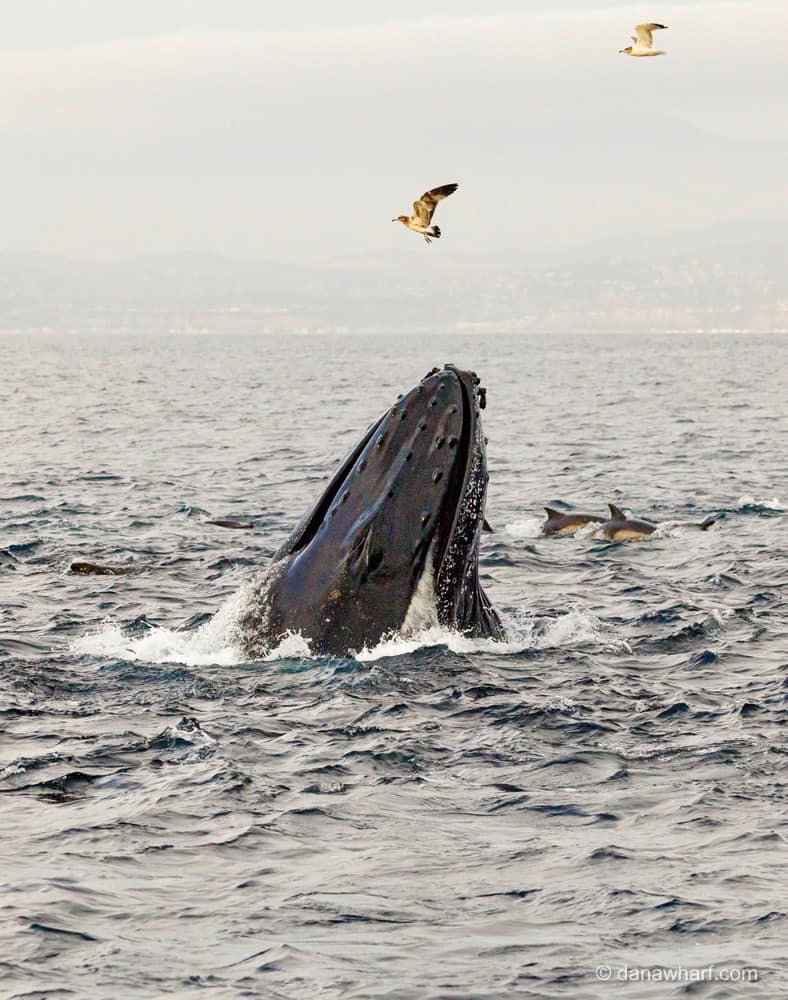The Ocean’s Stars: Ranking Whale Sightings Off Dana Point

Get ready to embark on an unforgettable journey into the heart of the Pacific! From the smallest to the largest, Dana Point’s coastal waters are a year-round playground for an incredible variety of whale species. While our expert captains and naturalists are always scanning the horizon, some encounters are more likely than others.
Here’s your insider’s guide to the whales you can expect to see, ranked from the most common to the truly extraordinary, when you set sail with Dana Wharf Sportfishing & Whale Watching.
Tier 1: Highly Common (Almost Guaranteed in Season / Frequent Year-Round)
These are the stars of our show, offering consistent and often spectacular sightings.
- Gray Whales (December – May, Peak Jan-Mar):
- Why they’re common: Dana Point is directly on the “Gray Whale Highway” for their incredible 10,000-mile migration between the Arctic and Baja California breeding lagoons. They pass very close to shore, making them incredibly reliable sightings during their season.
- Characteristics: Known for their mottled gray skin, often covered in barnacles and whale lice. They can be very curious, sometimes approaching boats, and are known for “spyhopping” (lifting their head out of the water) and “breaching” (leaping out).

- Humpback Whales (Seen Year-Round, More Frequent Summer/Fall):
- Why they’re common: While they have migratory patterns, a healthy population of humpbacks are seen feeding off Southern California throughout the year, with increased activity when baitfish are abundant.
- Characteristics: The acrobats of the ocean! Humpbacks are famous for their spectacular breaches, tail lobs, and pectoral fin slaps. They have incredibly long flippers and a distinctive “hump” before their dorsal fin when they dive. Each whale’s fluke (tail) has a unique pattern, like a human fingerprint.

Tier 2: Fairly Common / Regular Seasonal Sightings
These whales are regularly spotted, especially during their peak feeding or migratory periods.
- Blue Whales (May – November, Peak Summer/Early Fall):
- Why they’re common in season: Dana Point lies near rich feeding grounds (upwellings create krill blooms) that attract these colossal creatures, the largest animals on Earth. Southern California waters are a significant feeding area for endangered blue whales.
- Characteristics: Unmistakable by their sheer size (up to 100 feet long!). They have a distinctive blue-gray coloration and a tall, columnar “blow” that can reach 30 feet high. Seeing one of these gentle giants is a truly humbling experience.

- Fin Whales (Seen Year-Round):
- Why they’re common: Fin whales are the second-largest whale species and are frequent visitors to our productive offshore waters, often found alongside blue whales during the summer.
- Characteristics: Known as the “greyhounds of the sea” for their incredible speed. They have a sleek, streamlined body and a distinctive asymmetrical coloring – dark on the left side of their lower jaw and white on the right.
- Minke Whales (Seen Year-Round):
- Why they’re common: Minke whales are the smallest of the baleen whales and are year-round residents, though their smaller size and elusive nature can sometimes make them harder to spot than their larger cousins.
- Characteristics: Dark on top with a white belly, and often display a distinctive white band on their flippers. They can be quite curious and sometimes approach boats.

Tier 3: Less Common / Opportunistic Sightings
These are special treats, requiring a bit more luck, but are certainly possible!
- Orcas (Killer Whales) (Seen Year-Round, but Unpredictable):
- Why they’re less common: While iconic, Orcas are not residents of our immediate coastal waters and typically travel in transient pods. When they are sighted, it’s often a highly anticipated and thrilling event.
- Characteristics: Instantly recognizable by their striking black and white patterns and tall dorsal fins. Different “ecotypes” (Bigg’s/transient, offshore, Eastern Tropical Pacific) have been observed, with Bigg’s Orcas (mammal-eating) being the most frequently sighted.

- Sperm Whales (Rare, Deep Offshore):
- Why they’re rare: Sperm whales are deep-diving whales that primarily hunt squid in very deep offshore waters, making them an infrequent sight close to the coast.
- Characteristics: The largest toothed whale, with a distinctive, massive, block-shaped head. Their spout is bushy and angled forward. They can hold their breath for extended periods, so surface sightings are brief but memorable.
- Pilot Whales (Rare, but Possible in Pods):
- Why they’re rare: Short-finned pilot whales are actually large oceanic dolphins that prefer deeper offshore waters. When they do appear, it’s usually in cohesive pods.
- Characteristics: Black or dark gray bodies, with a bulbous head and a prominent dorsal fin set forward on their back. They are highly social and can be quite active.
Tier 4: Extremely Rare / Exceptional Sightings
These are the lottery wins of whale watching – truly once-in-a-lifetime experiences.
- Bryde’s Whales (Extremely Rare):
- Why they’re extremely rare: Bryde’s whales (pronounced “broo-dess”) are warm-water baleen whales that are not commonly found in our coastal waters. Sightings are few and far between.
- Characteristics: Similar to fin whales but smaller, with three prominent ridges on their rostrum (snout) instead of just one.
- Sei Whales (Extremely Rare):
- Why they’re extremely rare: Another fast-swimming baleen whale, sei whales are typically found in more oceanic, offshore waters and are rarely seen close to shore.
- Characteristics: Sleek, dark gray body, similar in shape to a fin whale but without the asymmetrical coloring.
Beyond Whales: The Abundance of Dolphins!
While this blog focuses on whales, it’s crucial to remember that Dana Point is home to over 400,000 wild dolphins! You are virtually guaranteed to see one or more of these energetic species on every trip:
- Common Dolphins (Long-beaked & Short-beaked): Often seen in massive “megapods” of thousands, creating incredible “stampedes.”
- Bottlenose Dolphins: Larger, robust, and often seen closer to shore.
- Risso’s Dolphins: Distinctive scarred bodies from squid encounters, often seen in smaller pods.
- Pacific White-Sided Dolphins: Energetic and acrobatic, often seen in cooler months.
Your Next Whale Watching Adventure Awaits!
No matter the season, a whale watching tour from Dana Wharf offers an incredible opportunity to witness some of the ocean’s most magnificent creatures. While some sightings are less common than others, every trip is an adventure filled with the promise of a breathtaking encounter.
Book your Dana Wharf whale watching trip today and discover for yourself why Dana Point truly is the “Dolphin & Whale Watching Capital of the World!” You never know what incredible giant might appear next!
